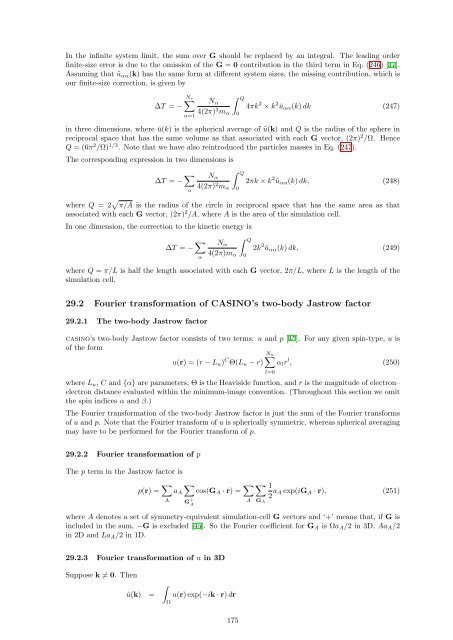CASINO manual - Theory of Condensed Matter
CASINO manual - Theory of Condensed Matter
CASINO manual - Theory of Condensed Matter
Create successful ePaper yourself
Turn your PDF publications into a flip-book with our unique Google optimized e-Paper software.
In the infinite system limit, the sum over G should be replaced by an integral. The leading order<br />
finite-size error is due to the omission <strong>of</strong> the G = 0 contribution in the third term in Eq. (246) [17].<br />
Assuming that ũ αα (k) has the same form at different system sizes, the missing contribution, which is<br />
our finite-size correction, is given by<br />
∑N s<br />
∫<br />
N Q<br />
α<br />
∆T = −<br />
4(2π) 3 4πk 2 × k 2 ū αα (k) dk (247)<br />
m α<br />
α=1<br />
in three dimensions, where ū(k) is the spherical average <strong>of</strong> ũ(k) and Q is the radius <strong>of</strong> the sphere in<br />
reciprocal space that has the same volume as that associated with each G vector, (2π) 2 /Ω. Hence<br />
Q = (6π 2 /Ω) 1/3 . Note that we have also reintroduced the particles masses in Eq. (247).<br />
The corresponding expression in two dimensions is<br />
0<br />
∆T = − ∑ α<br />
∫<br />
N Q<br />
α<br />
4(2π) 2 m α<br />
0<br />
2πk × k 2 ũ αα (k) dk, (248)<br />
where Q = 2 √ π/A is the radius <strong>of</strong> the circle in reciprocal space that has the same area as that<br />
associated with each G vector, (2π) 2 /A, where A is the area <strong>of</strong> the simulation cell.<br />
In one dimension, the correction to the kinetic energy is<br />
∆T = − ∑ α<br />
∫<br />
N Q<br />
α<br />
4(2π)m α<br />
0<br />
2k 2 ũ αα (k) dk, (249)<br />
where Q = π/L is half the length associated with each G vector, 2π/L, where L is the length <strong>of</strong> the<br />
simulation cell.<br />
29.2 Fourier transformation <strong>of</strong> <strong>CASINO</strong>’s two-body Jastrow factor<br />
29.2.1 The two-body Jastrow factor<br />
casino’s two-body Jastrow factor consists <strong>of</strong> two terms: u and p [45]. For any given spin-type, u is<br />
<strong>of</strong> the form<br />
∑N u<br />
u(r) = (r − L u ) C Θ(L u − r) α l r l , (250)<br />
where L u , C and {α} are parameters, Θ is the Heaviside function, and r is the magnitude <strong>of</strong> electron–<br />
electron distance evaluated within the minimum-image convention. (Throughout this section we omit<br />
the spin indices α and β.)<br />
The Fourier transformation <strong>of</strong> the two-body Jastrow factor is just the sum <strong>of</strong> the Fourier transforms<br />
<strong>of</strong> u and p. Note that the Fourier transform <strong>of</strong> u is spherically symmetric, whereas spherical averaging<br />
may have to be performed for the Fourier transform <strong>of</strong> p.<br />
l=0<br />
29.2.2 Fourier transformation <strong>of</strong> p<br />
The p term in the Jastrow factor is<br />
p(r) = ∑ ∑<br />
a A cos(G A · r) = ∑<br />
A<br />
A<br />
G + A<br />
∑<br />
G A<br />
1<br />
2 a A exp(iG A · r), (251)<br />
where A denotes a set <strong>of</strong> symmetry-equivalent simulation-cell G vectors and ‘+’ means that, if G is<br />
included in the sum, −G is excluded [45]. So the Fourier coefficient for G A is Ωa A /2 in 3D, Aa A /2<br />
in 2D and La A /2 in 1D.<br />
29.2.3 Fourier transformation <strong>of</strong> u in 3D<br />
Suppose k ≠ 0. Then<br />
ũ(k) =<br />
∫<br />
Ω<br />
u(r) exp(−ik · r) dr<br />
175

















